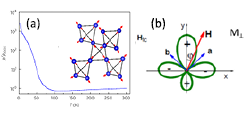Orthogonal Magnetization and Symmetry Breaking in Pyrochlore Iridate Eu2Ir2O7
Nakatsuji Group
It has long been known that magnets are magnetized along the external magnetic field. However, magnetization perpendicular to the field is also expected according to thermodynamic theory. This orthogonal magnetization is so tiny that no study so far had been able to detect it experimentally.

Fig. 1 (a) Metal insulator transition observed in the temperature dependence of the resistivity for Eu2Ir2O7 (main panel) and all-in all-out magnetic order (inset). (b) Octupole moment obtained from the orthogonal magnetization.
Tian Liang and their collaborators in Princeton University and the Massachusetts Institute of Technology in the U.S. and the research group led by Professor Satoru Nakatsuji noticed slight changes in magnetization in the pyrochlore iridate Eu2Ir2O7 following metal-insulator transition accompanied by the all-in all-out magnetic order (Fig 1 (a)). Usually, only the magnetic component parallel to the field is detected when measuring magnetization; the researchers thus attempted to detect magnetization perpendicular to the field by measuring the torque magnetometry, or force producing the tendency of magnets to rotate in a magnetic field, by cantilever and found that orthogonal magnetization abruptly increases below the metal-insulator transition temperature. The group determined that orthogonal magnetization derives from the special spatial distribution of the magnetic charge (magnetic octupole, Fig. 1 (b)), and that this is the origin (order parameter) of the metal-insulator transition.
This tiny orthogonal magnetization is instrumental in initiating the transition of metal into insulator, and carries the potential for use in such applications as magnetic memory and magnetic sensors. This work also gives a hint how to control the transport properties in Pyrochlore iridate, where the mysterious spontaneous anomalous Hall effect in nonmagnetic metallic phase with topological band structure is observed [2].
References
- [1] T. Liang, T. H. Hsieh, J. J. Ishikawa, S. Nakatsuji, L. Fu, and N. P. Ong, Nature Physic 13, 599 (2017)
- [2] Y. Machida, S. Nakatsuji, S. Onoda, T. Tayama, and T, Sakakibara, Nature 463, 210 (2010).
